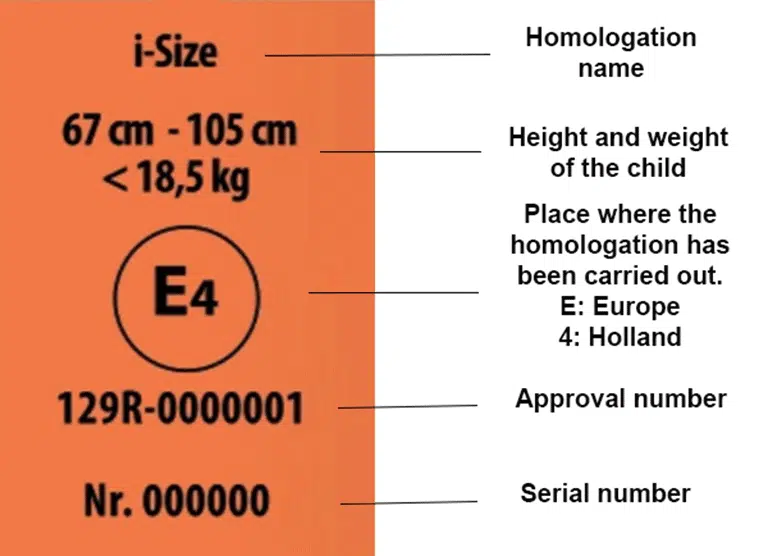i-Size approval standard

Until now, for a child seat to be used in Spain (and throughout the EU) it had to pass the tests included in the ECE R44/04 type approval standard.
Currently, the process of phasing out Regulation 44/04 has begun, to be replaced by a new regulation, Regulation 129. In 2025, this process of phasing out will be completed with the prohibition of the sale of Regulation 44.04 devices in Europe. The new regulation was created with the aim of simplifying the process of choosing and using child seats, making them more universal and easier to use. It is a kind of super ISOFIX. Indeed, it is precisely from the word ISOFIX that the letter i in the name of this new standard, i-Size, is derived.
Why a new standard?
The new standard was created with the aim of simplifying the whole process of choosing and using child seats, making them more “universal” and easier to use.
In fact, the new standard can be understood as a “super ISOFIX”. It is actually from the word ISOFIX that the letter “i” is taken for the name “i-size”.
What are the main differences compared to the current ECE R44/04 standard?
The main new features of the ECE R129 approval standard are:
- Classification according to groups 0/0+/I/II/III (and their corresponding weight ranges) is dropped, and each seat will simply indicate the size (height) and maximum weight of the children who can use it: something similar to how children’s clothing sizes are selected.
- A new side crash test is added, which improves seat safety in this type of crash.
- It ensures that all rear-facing seats can be used until at least 15 months of age. By doing so it encourages the use of rear-facing child seats, which is a much safer position for children when traveling than a forward-facing seat.
- Maximum child seat dimensions and minimum vehicle seat dimensions are determined, so that a seat that has been approved according to this “i-size” standard can be used in any “i-size” vehicle seat. This means that it will differ from the current ECE R44/04 standard, in which there were universal seats, semi-universal seats for certain vehicle models, specific seats, etc. In the case of ECE R129, all seats will be “universal” and can be used in all vehicles with “i-size” seats.
- Crash tests will be performed with new dummies, and incorporating new and more advanced injury criteria.
How do you recognize an “i-size” seat?
![]()
The “i-size” child seats, approved according to the new ECE R129 regulation, will also display the following logo with the letter “i”:
![]()
In addition, vehicle seats that comply with the “i-size” dimensions, ensuring that any “i-size” child seat can be installed in them, will also display the above logo.
Are the seats approved according to the new ECE R129 standard better?
Yes, they should be: this is precisely why a new standard has been developed, to improve the safety and comfort of use of child seats.
First of all, the new standard adds a new side crash test to check the protection of the seat in this type of impact. Secondly, the ECE R129 regulation ensures that an “i-size” seat can be installed in any car seat that is also “i-size”, which is much better than the current situation where some ISOFIX child seats could only be installed in certain vehicle models.
In summary, the main advantages of the “i-size” seats are:
- Better protection for the head and neck in the event of a head-on collision, due to an emphasis on using rear-facing seats which is a far safer position for children than traveling facing forward, at least until they are up to 15 months old.
- Better protection in case of side impacts
- Less risk of installing the seat incorrectly
Is the new rule already in force? Can you already buy seats that are approved according to the new standard?
In Spain, you can legally purchase and use “i-size” child seats already. *
* The OFFICIAL STATE GAZETTE, No. 158 dated Monday, June 30, 2014 Sec. I. Page 49879 published Order IET / 1105/2014 of the MINISTRY OF INDUSTRY, ENERGY AND TOURISM, of June 26, updating Annexes I and II of Royal Decree 2028/1986, of June 6, on the regulations for the application of certain EEC directives, relating to the type approval for motor vehicles, trailers, semi-trailers, motorcycles, mopeds and agricultural vehicles, as well as parts and pieces of said vehicles, and where it is indicated that ECE R129 is optional.
Are "i-size" child seats already available? And vehicles with "i-size" seats?
There are already many devices on the market with the new approval, and i-size approved vehicles. However, the regulation also allows vehicles with seats suitable for semi-universal CRS (with a support leg) to install i-Size CRS.
Does the new standard replace the old one?
Yes, at the level of approvals the new regulation has replaced the ECE R44/04 regulation.
This means that child restraint systems can no longer be approved according to Regulation 44.04.
This substitution also affects the sale of the product, and as of September 2025, products will not be marketed under regulation 44/04 in Europe.
With respect to their use, there is currently no restriction on the use of devices approved under Regulation 44.04, so these can continue to be used for the next few years.
Can I continue to use a car seat approved according to ECE R44/04?
Until September 2025, anyone can purchase a seat approved under either of the two standards.
It must be emphasized that we are talking about approval. We can continue to use a seat approved under the R44 regulation until otherwise stipulated.
Can an “i-size” child seat be used in a vehicle that does not have “i-size” seats?
If ISOFIX seats with a support leg can be installed in the vehicle, the regulation allows the installation of “i-size” seats as well.
Does the new standard cover all types of child seats?
Yes.
The new standard allows all types of child seats to be approved. The application of the regulations has been developed in phases
The first phase of the new EC R-129 regulation, known as i-Size, was approved in November 2012 and came into force in 2013. This stage only covers integrated seats, in other words, those which have a harness to secure the child in the seat and must be fitted with the ISOFIX restraint system.
The second phase was approved in 2017 and refers to non-integral restraint devices, namely those which are attached using the car’s seat belt, and for children over 100 cm in height. This second stage advocates for the use of booster seats with backrests.
The third phase was approved in 2019 and addresses the approval of devices that are attached using seat belts.
The fourth phase was approved in 2020 and defines the criteria for the approval of backless booster seats.
What does the approval label look like?
An example of an i-Size approval label:

